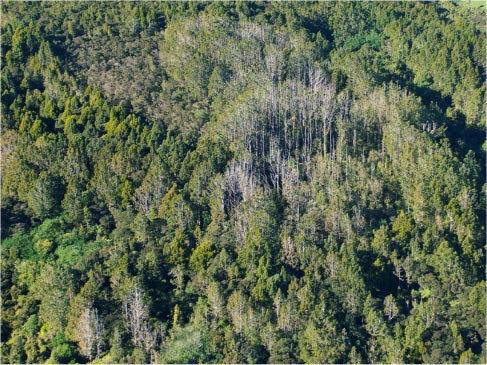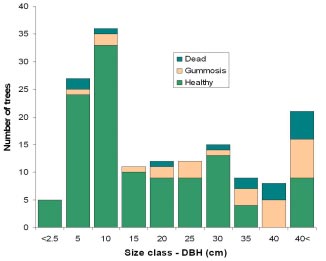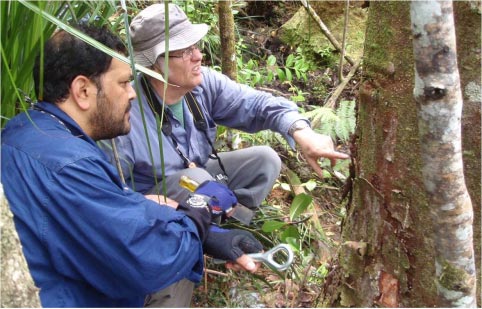PESTS AND DISEASES OF FORESTRY IN NEW ZEALAND
Phytophthora taxon agathis and management of kauri dieback
Scion is the leading provider of forest-related knowledge in New Zealand
Formerly known as the Forest Research Institute, Scion has been a leader in research relating to forest health for over 50 years. The Rotorua-based Crown Research Institute continues to provide science that will protect all forests from damage caused by insect pests, pathogens and weeds. The information presented below arises from these research activities.
From Forest Health News 208, August 2010.
An update by the late Ross Beever (Principal Plant Pathologist and Mycologist, Landcare Research Manaaki Whenua).

In the October 2009 issue of Forest Health News (No. 199), Peter Gadgil made some comments and raised some issues about Phytophthora taxon Agathis or PTA, a fungus that has been in the news over the last 6 months in relation to kauri health. In doing so he implied that the threat posed by this pathogen may be overrated. I respond as lead author of the paper that concluded that there is sufficient evidence to propose that PTA does pose a threat to kauri (Beever et al 2009).
As he points out, PTA is not a newly recognized pathogen of kauri. Indeed almost 40 years ago Peter studied the fungus and reported his findings in a short informative paper (Gadgil 1974). He identified the pathogen as Phytophthora heveae, on the basis of morphology and cultural characters, an entirely reasonable identification at the time. However, based on slight morphological features and on DNA sequencing studies, we decided that the kauri organism does not fit into the present day concept of P. heveae, and thus we provided it with the ‘tag’ name awaiting more detailed genetic studies. It is unfortunate that this re-naming has apparently resulted in some concluding that PTA is a newly discovered pathogen and entirely appropriate for Peter to set the record straight.
Peter studied the disease associated with the pathogen on Great Barrier Island in 1972. He isolated it from bleeding cankers on dying saplings and rickers and also conducted pathogenicity tests demonstrating it was highly virulent to kauri seedlings. In 2006 we observed trees with similar symptoms, in a ricker stand in the Waitakere Ranges (Maungaroa Ridge), and also isolated the pathogen from these lesions. We subsequently repeated the pathogenicity tests with kauri seedlings and also found it highly virulent to kauri. At the same time we also compared its pathogenicity on a range of other native species found in kauri forest and found they were not affected.

Despite its obvious pathogenicity to kauri, “P. heveae” came to be regarded as an insignificant pathogen of kauri. In his 1974 paper, Peter concluded that “P. heveae” did not pose a significant threat to kauri because of a number of features. Firstly, it was known at just one remote site (Great Barrier Island), where it was causing only minor damage. Secondly, the fungus could be found in the soil both at the diseased site and also from two apparently ‘healthy’ kauri sites, one adjacent to the diseased site and one 4 km away. Peter concluded that because “P. heveae” was present in the soil under healthy trees, ‘it was apparent that the fungus was pathogenic only under a specific combination of environmental conditions. Thirdly, ‘most of the affected trees’ on Great Barrier apparently recovered the summer following the initial observations.
So one can ask, why did we conclude the PTA does indeed pose a threat to kauri? Considering the 3 main features raised by Peter, first and foremost, PTA was found to be present in the Waitakere Ranges and at Trounson Park close to Waipoua Forest. It could no longer be regarded as present only in an isolated part of kauri’s home range. Also, it was not found to be behaving as a ‘minor’ pathogen with about 30% of rickers either dead or with unusual gummosis (resinosis) at two separate sites in the Waitakere Ranges.
We also suggested that the partially dead (stag headed) mature kauri in the relatively unmodified Cascades region of the Waitakere Ranges might be infected by PTA. Subsequent to our paper, we have recovered PTA from a collar rot of a large (2.3 m DBH) tree in this region. Secondly, we concluded that the presence of PTA in soil under healthy trees does not detract from its threat status. In the case of its presence under healthy trees close to the original diseased site on Great Barrier Island, it is reasonable to conclude that it may have been infecting kauri roots of apparently healthy trees that subsequently developed disease symptoms once the disease had progressed to the collar and girdled the tree.
Observations in 2006 of the original diseased site indicated that significant spread of the disease symptoms which supported this possibility. The conclusion that the presence of PTA in the soil some 4 km from the diseased site indicates that the pathogen is only pathogenic under a specific set of environmental circumstances is more difficult to assess. The disease triangle, implying that disease is a result of interplay between the host plant, the environment, and the pathogen, is a basic axiom of plant pathology. Thus the conclusion should perhaps be recast to suggest PTA is exacerbated by a specific, though as yet unidentified, set of environmental circumstances. It would be worthwhile to revisit the distant healthy site, to see whether or not trees there are showing symptoms. It is unlikely PTA has persisted there without causing some root damage (Phytophthora species are generally regarded as poor saprotrophs). Not that I exclude environmental factors acting to exacerbate the disease symptoms. In the case of some of the affected ricker stands we have inspected, such as the Maungaroa ridge site in the Waitakeres, there was considerable ground and root disturbance due to the presence of pigs. This disturbance could well serve to spread the pathogen around the base of infected trees and cause wounds leading to more infected roots, as well as damaging many of the healthy roots. The third feature suggesting that the pathogen is of minor importance was that ‘most of the affected trees’ on Great Barrier recovered during the drought the following season. This is difficult to assess. I suspect it refers to the regreening of yellowish foliage as assessed from a distance. While I agree that such yellowing is a common symptom of infected trees, it seems unreasonable to conclude that these trees successfully eliminated the infections when the area of dead and dying trees had increased some 30 years later. It is more likely that the change in appearance reflects the ‘natural’ cycles of environmentally driven changes in leaf colouration reported for kauri.

So, should PTA be regarded as an ‘insignificant pathogen’ (Gadgil 2009) or a ‘threat to kauri’ (Beever et al 2009)? And if it poses a threat, how significant is that threat? I suggest that the evidence gathered in the last few years, presented at an international meeting in 2007, and made available to interested parties prior to formal publication (Beever et al. 2009), warranted PTA being taken seriously by those charged with kaitiaki roles for kauri. The Auckland Regional Council (ARC) accepted this argument and in May 2008, initiated various precautionary management responses, including various ways of restricting spread through soil movement. This was done despite the very limited amount of information available on this pathogen to help guide this response. Subsequently (October 2008), MAF Biosecurity New Zealand declared PTA an unwanted organism under the Biosecurity Act, and coordinated a response by a Joint Agency comprising those agencies with management responsibilities for kauri forest in public ownership (Department of Conservation, Northland Regional Council, ARC, Environment Waikato, Environment Bay of Plenty). This group assessed the situation and developed a case for long term management of kauri dieback funded by central and local government. In 2009, the Ministers of Conservation and Biosecurity announced a sum of $4.7 million over 5 years to be matched by similar level of local council government to fight kauri dieback. It is apparent that first the ARC and then the Joint Agency were acting on ‘the precautionary principle’.
The sum total of scientific papers published on PTA is two, although a search for Phytophthora taxon Agathis on Google yielded 1950 ‘hits’ (accessed February 2010). In assessing risk it is important to consider both the likelihood of an event happening as well as the impact if the event did happen. Kauri is significant taonga for Maori and a much cherished icon for Pakeha. It is clear that much scientific research is needed to help clarify the risk and guide a long term management programme of kauri dieback.
Ross Beever1 , Landcare Research
 More information
More information
For the latest information on the kauri dieback programme go to: www.kauridieback.co.nz
Further correspondence on this article email:
nick.waipara@arc.govt.nz
References and Further Reading
Beever, R.E.; Waipara, N.W.; Ramsfield T.D.; Dick, M.A.; Horner, I.J. 2009: Kauri (Agathis australis) under threat from Phytophthora? pp. 74-85 in “Phytophthoras in Forests and Natural Ecosystems”, Proceedings of the Fourth Meeting of IUFRO Working Party S07.02.09, (Goheen, E.M.; Frankel, S.J. tech. cords.), General Technical report PSW-GTR-221, USDA Forest Service, Albany, CA, USA.
Beever, R.E.; Waipara, N.W.; Ramsfield T.D.; Dick, M.A. 2010: Pathogenicity of Phytophthora taxon Agathis (PTA). Phytophthoras in Forests and Natural Ecosystems; The Fifth Meeting of the International Union of Forest Research Organisations (IUFRO) Working Party 7.02.09, March 2010, Rotorua, New Zealand.
Bellgard, S.E.; Beever, R.E.; Padres, E. 2010: Comparative efficacy of hygiene treatments used for disinfestations of Phytophthora taxon Agathis (PTA) inoculum contained in soil. Phytophthoras in Forests and Natural Ecosystems; The Fifth Meeting of the International Union of Forest Research Organisations (IUFRO) Working Party 7.02.09, March 2010, Rotorua, New Zealand.
Gadgil, P.D. 1974: Phytophthora heveae, a pathogen of kauri. New Zealand Journal of Forestry Science 4:59-63.
Gadgil, P.D. 2009: Phytophthora ‘Taxon Agathis’, A new pathogen of kauri? No, Just an old one under a different name. Forest Health News 199, October 2009.
Waipara, N.W.; Davis, A.; Meys, J.; Osborne, B.; Lee, P.; Peart, A.; Campion, A.; Hill, S.; Sheeran, B.; Craw, J.; Bellgard, S.E.; Beever, R.E. 2009: Management of Kauri dieback and Phytophthora ‘taxon Agathis’ Proceedings of the IUFRO International Forest Biosecurity Conference Incorporating the 6th International Forest Vegetation Management Conference 16-20 March 2009 Rotorua New Zealand Pp 101-103.
Waipara, N.; Davis, A.; Hill, S.; Brooks, J,; Pengelly, M.; Barr, J.; Bellgard, S.; Beever, R.E. 2010: Management of kauri dieback and Phytophthora taxon Agathis (PTA). Phytophthoras in Forests and Natural Ecosystems; The Fifth Meeting of the International Union of Forest Research Organisations (IUFRO) Working Party 7.02.09, March 2010, Rotorua, New Zealand.
1 At the time of writing this article Dr Ross Beever passed away after a short illness. Ross was leading the national research programme into kauri dieback. We offer our condolences to his wife, family, many friends and colleagues. We also recognize his immense contribution to New Zealand and international science across his many research interests and projects in the fields of botany, ecology, plant pathology and mycology.
This information is intended for general interest only. It is not intended to be a substitute for specific specialist advice on any matter and should not be relied on for that purpose. Scion will not be liable for any direct, indirect, incidental, special, consequential or exemplary damages, loss of profits, or any other intangible losses that result from using the information provided on this site.
(Scion is the trading name of the New Zealand Forest Research Institute Limited.)

 Farm Forestry New Zealand
Farm Forestry New Zealand

